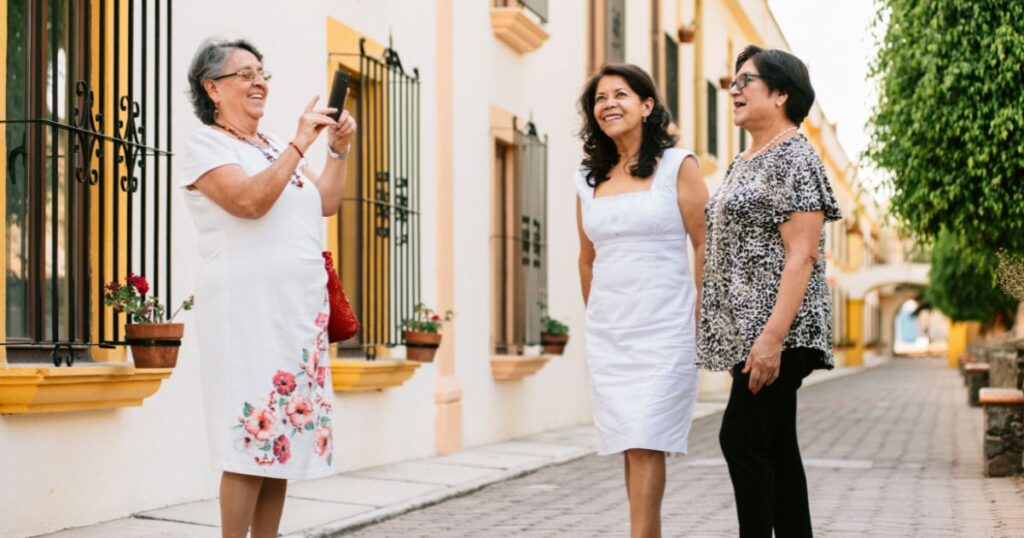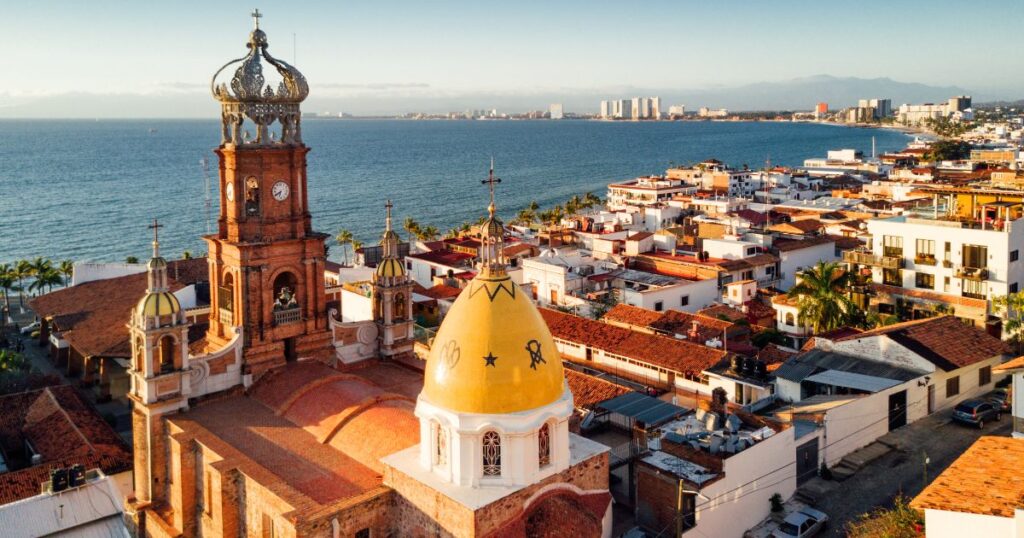Between the warm weather, vibrant culture, low property taxes, and reasonable cost of living, Mexico is an excellent retirement option — one that’s well within grasp for many retirees. Of course, before you make the leap, you should consider the practical aspects of moving there.
Read on to learn about everything from visa requirements to healthcare options to tax obligations and more in our guide to retirement in Mexico!
📋 Key Updates for Retiring in Mexico in 2025
- Expats have access to two main healthcare options in Mexico: the government-run Instituto Mexicano del Seguro Social (IMSS) costing around $218 to $590 USD per year, and private healthcare, which averages around $1,700 USD per year with a deductible of $5,000 USD.
- Financial Requirements for Visas: The financial requirements for Mexican residence visas have been updated. To qualify for a temporary residence visa in 2024, applicants need a monthly income of $4,350 USD (and $4,100 USD for 2025) or savings of $73,200 USD (and $70,000 for 2025). For the permanent residence visa, the income requirement for 2024 rises to $7,300 USD per month (and $7,100 for 2025) or savings of $300,000 USD (and $280,000 for 2025).
Mexico continues to be a top retirement destination
Mexico is one of the top foreign destinations for retirees. The US Social Security system sent an estimated 62,000 payments to Mexico in December 2023, the third-most of any foreign country (behind Canada and Japan).1
Why do Americans move to Mexico?
Some of the most common reasons Americans move to and retire in Mexico include:
- The pleasant year-round weather
- The affordable cost of living
- The ability to immerse yourself in Spanish
- The large expat and welcoming local communities
- The rich culture
What currency is used in Mexico?
The currency used in Mexico is the Mexican peso. $1 USD is equal to about $20.28 Mexican pesos (MXN).
Visas for retiring in Mexico
The two primary visas that retirees apply for are the temporary residence visa and the permanent residence visa.
The financial requirements for the temporary residence visa are lower, but the visa initially only lasts for one year. After, it can be renewed for up to three years, at which point the holder can apply for a permanent visa.
Permanent residence visas, on the other hand, come with higher financial requirements but last indefinitely.
Is it hard to get a visa to retire in Mexico?

As long as you meet the requirements, getting a residence visa is fairly straightforward for retirees. The most important factor is whether you’re considered economically solvent.
Temporary Residence Visa financial requirements
If applying from your home country, (as most Americans will, unless they have family in Mexico), applicants for the temporary residence visa must either:
- Earn a monthly income of $83,700 Mexican pesos (~$4,185 USD)*, OR
- Have $1,522,459 Mexican pesos (~$69,750 USD)* in savings
Bringing a dependent spouse requires an additional $27,900 Mexican pesos (~$1,376 USD)* per month in income.
Permanent Residence Visa financial requirements
Similarly to above: If applying from your home country, (as most Americans will, unless they have family in Mexico), applicants for the Permanent Residence Visa must either:
- Earn a monthly income of $151,758.24 Mexican pesos (~$7,300 USD)*, OR
- Have $6,236,640 Mexican pesos (~$300,000 USD)* in savings
Again, bringing a dependent spouse requires an additional $27,900 Mexican pesos (~$1,395 USD)* per month in income.2
*Requirements may vary depending on which Mexican consulate you apply at
Additional requirements
Beyond the financial requirements listed above, applicants must also:3
- Pay a visa application fee of ~$54 USD & a residence card fee of ~$300 USD
- Convert their permanent residence visa into a permanent residence card within 30 days of arriving in Mexico
- Submit the required documents:
- Completed visa application form
- Valid passport & copy
- Passport-sized pictures
- A booked flight ticket
- 6-12 months of bank account or financial statements demonstrating economic solvency
How long does it take to get a visa to live in Mexico?
Assuming you meet all the criteria and have provided the correct documentation, you should receive your visa within 10-15 working days of submitting your application.
Best cities in Mexico for retired US expats

There are a number of great places in Mexico for US expats to live in their retirement — from bustling Mexico City to quaint Oaxaca — but a few of the top options include:
Mérida
Mérida, located along the highly desirable Yucatán peninsula, is one of the safest places in Mexico. It’s known for its white stone buildings, Mayan ruins, and beautiful natural sinkholes called cenotes.
How much does it cost to live in Mérida?
Monthly expenses for a couple living in Mérida generally total $1,600 USD per month.4
Ajijic, Lake Chapala
With an estimated 20,000 expats living in Ajijic, a small town on Lake Chapala, it’s one of the largest expat communities in Mexico. It’s known for its regular town festivals, temperate weather year-round, and stunning mountain views.
How much does it cost to live in Ajijic, Lake Chapala?
Monthly expenses for a couple living in Ajijic, Lake Chapala, generally total between $1,800-$2,000 USD per month.5
Puerto Vallarta
Resort town Puerto Vallarta is a popular destination for tourists and retirees alike. It is well known for its beaches, welcoming community, and stunning art galleries.
How much does it cost to live in Puerto Vallarta?
Monthly expenses for a couple living in Puerto Vallarta generally total between $1,500-$2,000 USD per month.6
San Miguel de Allende
San Miguel de Allende may not have any beaches, but it does offer charming Colonial architecture, cobblestone streets, “eternal spring” weather, and breathtaking sunrises and sunsets.
How much does it cost to live in San Miguel de Allende?
Monthly expenses for a couple living in San Miguel de Allende generally total $1,700 USD per month.7
Playa del Carmen
Playa del Carmen, a popular resort town located on the Yucatán peninsula, is known for its white sand beaches, turquoise waters, surrounding jungle, and ancient ruins.
How much does it cost to live in Playa del Carmen?
Monthly expenses for a couple living in Playa del Carmen generally total between $1,400-$1,900 USD per month.8
Healthcare in Mexico for expats
Expats in Mexico tend to choose between:
- Instituto Mexicano del Seguro Social (IMSS): This is the Mexican government-run health system, available for foreign residents at a cost of around $2,000 to $5,500 Mexican pesos (~$114 to ~$313 USD) per year, depending on your age and health. While costs are low, waits can be long, not all services/medications are covered, and it is administered entirely in Spanish9
- Private healthcare: Most expats opt for private insurance, which, although more expensive, tends to be more comprehensive. The costs vary widely depending on your age, health, and other factors, but average about $1,700 USD per year with a deductible of $5,000 USD10
How much money do you need to retire to Mexico from the US?
The exact amount of money you need to comfortably retire in Mexico will depend on your lifestyle and location, but the cost of living tends to run less than $2,500 USD per month for a couple.11 Remember, though, that the definition of “economic solvency” is significantly higher than that, starting at about $3,540 USD per month for a temporary residence visa.
Retiring in Mexico on Social Security: Considerations
Given that the minimum monthly income to qualify for a Mexican residence visa is $3,540 USD per month, and the average monthly social security check is only about $1,827 USD,12 social security alone won’t be enough to qualify for economic solvency unless you already have a minimum of ~$58,996 USD in savings.
Do Americans pay taxes in Mexico?
Yes. Americans living in Mexico under a temporary or permanent residency visa are considered tax residents of Mexico. In addition, they also must pay US taxes, since America’s tax system requires that all citizens and permanent residents file a federal tax return — provided that they meet the minimum income reporting threshold — regardless of where in the world they live.
Tax planning for American retirees in Mexico

While the numerous benefits of retiring in Mexico make it well worth the effort, it can complicate your US taxes. That’s where Bright!Tax comes in. Leaving US taxes to us means you can spend more time enjoying your hard-earned retirement.
Resources:
- Retiring in Mexico: What You Need to Know
- Financial Criteria for Legal Residency in Mexico 2025
- Mexico Permanent Residence Permit
- 7 Best Places To Retire in Mexico
- Yes, You Can! Retire in Ajijic on Less Than $2,000 A Month
- Puerto Vallarta, Mexico
- Cost of Living Playa del Carmen for Digital Nomads [Full Breakdown]
- Expats Have Access To Healthcare in Mexico on 3 Levels
- Health and Medical Insurance Options for Mexico
- Health Insurance and Healthcare in Mexico Explained
- Finding the Perfect Place to Retire in Mexico
- How much Social Security will I get?
FAQ: Retiring to Mexico
-
Are there retirement communities in Mexico?
Yes, there are many different retirement communities in Mexico. Some examples include CasaMar Senior Living in Rosarito, La Pueblita in Lake Chapala, and Ballesol Mexico in Querétaro.
-
What is the average income in Mexico?
The average income in Mexico is about $16,269 USD per year. In comparison, the average income from US social security alone is about $21,924 USD.

 Connect on LinkedIn
Connect on LinkedIn





